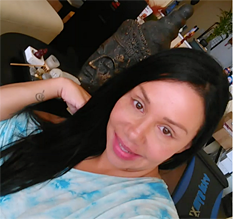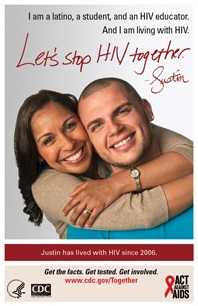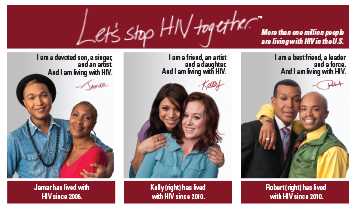Get Involved

Stopping HIV in the United States is possible, but to achieve this each and every one of us must act and get involved. Whether you are an individual or an organization, you have an opportunity to take action. A little help can go a long way, and you can make a difference. We can all do something to help stop HIV.
You can help reduce stigma and increase awareness and knowledge about HIV by sharing your own messages of hope and encouragement using the ideas, tools, and resources on this page.
Let’s stop HIV together by:
- Talking openly about HIV
- Sharing your personal story with others
- Engaging in social media
- Connecting with your community by hosting an event or volunteering
- Building a coalition
Talking Openly about HIV
Get involved in the conversation. The first step to stopping HIV is talking openly about it. For some people, it may feel uncomfortable and embarrassing at first, but talking openly about HIV can help make these conversations less awkward. By sharing accurate information about HIV, we can make sure that everyone learns the facts, including how HIV is transmitted and how to prevent getting HIV.
Every conversation we have about HIV helps eliminate the stigma often associated with the disease. Stigma is the shame or disgrace tied to something viewed as socially unacceptable. Labeling and stereotyping people based on prejudice against a certain trait leads to stigma which sets these people apart from the rest of society and can keep people from accessing medical care, employment, and even housing. Stigma also leads to feelings of shame and isolation among those discriminated against, leading many to deny symptoms and delay or avoid treatment. More than three decades after initial HIV diagnoses were made, stigma remains a barrier to stopping HIV in the United States. Certain words and language used in the context of HIV and AIDS may have negative meaning for those at high-risk or who are living with HIV and may result in real or perceived stigma, discrimination, fear, and anxiety, which prevents some people from getting tested and treated. We can all start by being thoughtful about our words, and choosing to use supportive—rather than stigmatizing—language when talking openly about HIV.
When having conversations about HIV and sharing messages on social media or other media and communications outlets, keep in mind the following tips:
- Keep language general. Using exaggerated phrases or exclamation marks in some contexts may fuel stigma, discrimination, fear and anxiety.
- Tune in and listen to what the other person might have to say. Correct myths about HIV by sharing the facts.
- Consider the preferred terms below to avoid promoting stigma and misinformation.
| Problematic word or phrase | Preferred word or phrase |
|---|---|
| AIDS (when referring to the virus, HIV) | HIV or HIV and AIDS when referring to both |
| Why: AIDS is a range of conditions, or a syndrome, that occurs when a person’s immune system is weakened by the HIV infection. AIDS itself is not an infection. Use each term separately or both when referring to both but do not use HIV/AIDS because this suggests that the terms are interchangeable. A person with AIDS is HIV-positive, but not everyone who is HIV-positive has developed or will develop AIDS. | |
| To catch AIDS To get AIDS To catch HIV To pass on HIV |
To be diagnosed with HIV To acquire HIV To transmit HIV |
| Why: AIDS cannot be caught or transmitted. People can become infected with HIV. HIV can be transmitted, but not inherited. | |
| Unprotected sex | Sex without a condom or medicines to prevent or treat HIV. |
| Body fluids | Blood, amniotic fluid, semen, pre-ejaculate, vaginal fluids, breast milk. |
| Why: Only some body fluids transmit HIV. ‘Body fluids’ cover all fluids coming from the body and not just those involved in HIV transmission. Be specific if you can. Knowing the facts can help reduce stigma. | |
| To battle HIV/AIDS War against HIV/AIDS |
Response to HIV and AIDS |
| Why: These terms may be considered militaristic and stigmatizing that may lead to the thinking that people living with HIV have to be ‘fought’ or eliminated. | |
| High(er) risk group(s) Groups with high risk behavior |
High risk behavior (unprotected sex, use of contaminated needles, etc.) Highly affected communities Key populations Key populations at higher risk |
| Why: These terms imply that membership of a particular group, rather than engaging in certain behaviors, can be the cause of becoming HIV positive. They may give a false sense of security to those who do not self-identify with one of these groups. | |
| Victims Sufferers Contaminated Sick |
Person/people with HIV Person/people living with HIV |
| Why: Some people living with HIV feel these terms imply that they are powerless, with no control over their lives. Also, these terms segregate the people currently living with HIV. | |
| AIDS patient HIV patient Patient |
Person with HIV Person living with HIV HIV-positive person |
| Why: A patient is someone who is seen by medical personnel in a medical setting. Outside of that clinical context, the person should not be referred to as a patient. The term implies a constant state of illness that can be misleading and demoralizing. | |
| Positives HIVers AIDS or HIV carrier |
HIV-positive people/person People/person living with HIV |
| Why: These terms may be offensive and stigmatizing to people living with HIV. A person is not HIV. A person lives with HIV once infected with the virus. | |
Remember, a conversation does not have to be face-to-face. Whether you talk, type, or text, what is important is that you start the conversation about HIV and pay particular attention to the words that you use in order to avoid labeling and stereotyping people living with HIV. No matter how you choose to be involved in the response to HIV, you can show your support by educating yourself and others about HIV and being thoughtful about the words you choose to use when talking about HIV. Used correctly and carefully, our words can be an important and powerful tool to stopping HIV and improving health outcomes for people living with HIV.
Find information and resources below:
- HIV.gov Talking About Your Status
- AIDSinfo/InfoSIDA Staying Healthy with HIV
- CDC.gov Living with HIV/AIDS
- Doing It
- HIV Treatment Works
- Start Talking. Stop HIV.
- We Can Stop HIV One Conversation at a Time
- Womenshealth.gov Living with HIV/AIDS
For information about how to talk to children about sex and HIV visit:
- CDC.gov Adolescent and School Health Sexual Risk Behavior: HIV, STD, & Teen Pregnancy Prevention
- Parents Matter!, an evidence-based prevention program for parents of pre-teens.
Share Your Story
Share your personal HIV story with others.
Stories have power, and every voice and every story is important. HIV affects each individual differently and everyone’s story of living with HIV is unique. The personal stories of Let’s Stop HIV Together campaign participants help highlight the fact that HIV touches every corner of American society and people living with HIV are part of the fabric of our families and valued members of our communities. Stories like these are powerful testimonies and reminders that HIV is still with us and affects us in so many ways.
Across the country, people just like you are speaking up about HIV. We encourage everyone affected by HIV to share their stories on social media with posts, photos, and videos. Share your posts with us by including the campaign hashtag #StopHIVTogether.
Want to share your story but need some ideas? See below for some examples! You can see more on Facebook or on the Stories About Living with HIV section of this website
Get Involved on Social Media
Social media tools allow us to connect with people that we may never have the chance to meet otherwise. They also allow us to join our voices together to reach more people and have a greater impact. Whether you are using a computer, a tablet or smartphone, Let’s Stop HIV Together wants you to get creative and find new ways to tell the world about what you are doing to #StopHIVTogether.
Follow Us
Sample Facebook posts to get you started:
Use these hashtags
#StopHIVTogether
#StopHIVStigma
Awareness
Did you know? Anyone who is sexually active can get #HIV, chlamydia, gonorrhea, syphilis or other STDs. http://1.usa.gov/1EtRxb5
Models, martial artists, and Olympians are featured in CDC’s Let’s #StopHIVTogether campaign. Check out these posters!
www.cdc.gov/actagainstaids/campaigns/lsht/materials/posters.html
Do you know the basic information on #HIV/AIDS? Get the who, what, when, where, and why from @CDCgov. #StopHIVTogether
www.cdc.gov/actagainstaids/basics/index.html
We can #StopHIVTogether. I am learning more everyday so that I can be supportive of the person/people I know who is/are living with HIV. I get a lot of information from http://1.usa.gov/1EtRxb5
I talk to my friends about HIV and what we can do to #StopHIVTogether. What have you done this week to reduce stigma? http://1.usa.gov/1EtRxb5
Prevention
Are you on schedule with your #HIV testing? #StopHIVTogether http://1.usa.gov/1EtRxb5
Your story
I am living with #HIV and I do all I can to keep myself and my partner healthy. #GetTested and know that no matter what the results, there are people out there who care about you and support you. http://1.usa.gov/1EtRxb5
I am a woman living with #HIV. I am also a grandmother/mother/daughter/friend/partner/wife/teacher/student. HIV does not define me. A lot of other people are sharing their stories too – http://1.usa.gov/1EtRxb5
I #GetTested because I care about others who are living with HIV. I know my status and I talk openly about #HIV because having honest conversations can help reduce stigma that prevents people from getting and staying in care.
Sample Twitter posts to get you started:
Awareness
If you’re having sex, you can get #HIV, chlamydia, gonorrhea, syphilis, or other STDs.
Check out these inspiring #StopHIVTogether posters! https://www.cdc.gov/actagainstaids/campaigns/lsht/materials/posters.html
Get up to speed on basic #HIV/AIDS information from @CDCgov: https://www.cdc.gov/hiv/basics/index.html #HIV & #AIDS
Prevention
Are you on schedule with your #HIV testing? #StopHIVTogether
Learn more about getting a blood-free #HIV test http://1.usa.gov/1EtRxb5 #StopHIVTogether
This CDC list will help you learn to reduce your risk of #HIV exposure http://1.usa.gov/19p4mb6 #StopHIVTogether
Your story
How soon would you ask a new date their #HIV status? #safesex #StopHIVTogether
Infographics tell a story and share information in a visually appealing way. They invoke emotion and use both text and graphics. To make a big impact with your social media pages include these links and infographics in your posts.
Make Your Own #StopHIVTogether Video
Tell us how you’re working to #StopHIVTogether in your community by following 3 easy steps:
- Record a short video on your mobile device, tablet, or computer telling us how you work to #StopHIVTogether.
- Videos can be of you simply telling us about your experiences OR you can film some of the work you do in action (i.e. preparing for an event).
- Videos should be 15-60 seconds in length for Twitter and Instagram.
- Upload it to your preferred social media channel.
- Tag us in your video post and use the hashtag #StopHIVTogether
- Act Against AIDS has a presence on Facebook (@ActAgainstAIDS), Instagram (@ActAgainstAIDS), and Twitter (@TalkHIV)

Connecting with Your Community
There are a lot of ways to get involved in the HIV response in your community. You can organize a HIV awareness activity at your school, place of employment or church; you can volunteer your time and skills at an existing organization or group that is involved in the response to HIV; or simply, you can become an informed citizen.
CDC counts on leaders within the community to help extend the reach of “Let’s Stop HIV Together.” We encourage you to promote campaign messages at community events, on your organization’s website, and through social media or e-mail.
Download Campaign Materials
Whether you are planning or participating in a community event, we have materials that you can use to showcase your HIV awareness activities. These free, downloadable campaign materials will help spread the word in your community and raise awareness about the impact of HIV, the importance of HIV prevention and testing, the effects of stigma, and how we can work together to increase support for people living with HIV.
If you are looking for signs to use at an event, we’ve got that too. Contact CDC-INFO to request Let’s Stop HIV Together posters, pop-up banners, and photo backdrops.



Volunteer in Your Community
Donate your valuable time and skills! Being involved and active in your community is a great way to get information and help improve the services received by persons living with HIV. Volunteering is fun and fulfilling. Check out these activities that rely on people just like you. Your help is needed!
A Day with HIV is an anti-stigma campaign that encourages people everywhere, for one day out of the year – A Day with HIV – to share their story with the world and capture a moment of their lives. The pictures are then posted on social media and on adaywithhiv.com, with the hashtag #adaywithhiv.
HIV.gov also has a calendar with links to local events around the country https://www.hiv.gov/events/awareness-days
Not sure where to start? Try contacting your local AIDS service organizations and/or community health departments. These groups can help identify opportunities or other organizations that may need the support of volunteers. You can also visit the sites listed below to search HIV/AIDS-related volunteer opportunities for you, your family, and friends in your community.
Host an Event
You can organize your own event by partnering with a local health department or community-based organization. Another option is to find an event that is already taking place and ask the organizers to plan an HIV awareness activity as part of that event. Either way, local events are a great outlet for open discussions about HIV.
You can help promote the event within your community and among people living with HIV as well as their partners, friends, and families. Encourage community members to come together to support each other and work together to stop HIV.
Building a Coalition
There is power in numbers! With more people involved, we are able to accomplish more than any individual, organization, or institution can by working alone. Collaborative efforts allow us to extend the reach of HIV prevention messages, while providing partners an opportunity to engage in open and honest conversations using accurate information and appropriate language. We encourage you to use the collective strength and influence of a variety of groups or individuals, stakeholders, and partners to increase HIV/AIDS awareness, prevention, testing, and action within your community.
The Together Network might be able to help you connect with partners. The Together Network is a diverse group of HIV-positive individuals and their supporters from communities across the country who help CDC and the Let’s Stop HIV Together campaign to spread the message that HIV affects all of us. This coalition of campaign participants works with local organizations and community-based programs to speak out against stigma, promote HIV testing and treatment options, and improve the lives of people living with HIV. Visit the Together Network page to see if these campaign participants are working to stop HIV in your city or community.
- Page last reviewed: September 13, 2017
- Page last updated: September 13, 2017
- Content source:


 ShareCompartir
ShareCompartir